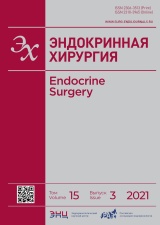BACKGROUND. Current trends of «fast track surgery» give rise to development of new safe techniques of the thyroid and parathyroid surgery, the purpose of which is to minimize the level of postoperative complications, such as vocal cord palsy, hypoparathyroidism, bleeding. In this regard, it is important for the endocrine surgeon to save «dry operating field», which contributes to the clear visualization of such «thin» structures as the recurrent laryngeal nerve, the external branch of the superior laryngeal nerve and the parathyroid glands. Therefore, the key issue of this surgery is to understand the anatomical and topographic features of the blood supply to the internal neck organs (a complex of neck organs consisting of the thyroid and parathyroid glands, larynx, trachea, esophagus).
AIM. To determine the main sources of arterial blood supply of the internal neck organs and their anatomical, topographic features.
MATERIALS AND METHODS. The computed tomography protocols of cervical branches of brachiocephalic arteries were analysed in the study. The thickness of the reconstructed sections in the axial, frontal and sagittal planes was 0.35±0.05 mm. The fact of blood supply was confirmed by the anatomical close of the arterial structure to the internal organ and the presence of intramural arterial branches.
RESULTS. The course of all cervical branches of the subclavian and common carotid artery was traced among 42 patients. It is noted, that only the inferior, superior thyroid arteries and thyroid ima artery supply internal neck organs with the blood. At the same time, the superior thyroid artery was visualized in all angiograms. However, the inferior thyroid artery was absent in 2.4% of cases. The thyroid ima artery was rarely detected (in 4.8% of patients). In 73.2% of cases, the inferior thyroid artery was detected high at the upper third level of the thyroid lobe and then had a descending course. In 23.2% of cases, the artery was formed at the middle third level of the thyroid lobe and was directed horizontally to the gland. Only in 3.6% of cases, the ascending course was determined in the vessel. The inferior thyroid artery was located on the posterior surface of the thyroid lobe, where it formed glandular branches. On the contrary, the branches of the superior thyroid artery were located mainly along the anterolateral surface of the thyroid gland. The average thickness of the inferior thyroid artery was 2.1±0.5 mm, and the superior thyroid artery was 1.6± 0.7 mm.
CONCLUSION. According to the study, arterial blood supply to the internal neck organs is provided mainly by the inferior and superior thyroid arteries. At the same time, the trunk of the inferior thyroid artery is larger than the superior thyroid artery (p=0.032). The inferior thyroid artery forms branches along the posterior surface of the thyroid lobe and from a topographic point of view it is the main source of blood supply to the parathyroid glands. In most cases, the inferior thyroid artery has a descending course, is directed along the posterior surface of the thyroid gland and forms an X-shaped intersection with the recurrent laryngeal nerve.

















































